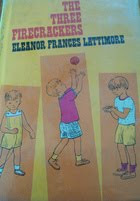84. The Three Firecrackers by Eleanor Frances Lattimore

The Three Firecrackers by Eleanor Frances Lattimore (USA) Out of Print
Pages: 127 pages
Ages: 7-10
Finished: May 15, 2010
First Published: 1970
Publisher: William Morrow and Company
Genre: children, realistic fiction
Rating: 3/5
First sentence:
It seemed to Rosie Warren like a long time since she had seen her sister Viola.
Acquired: Borrowed a copy through Inter-Library Loan.
Reason for Reading: Lattimore is one of my favourite childhood authors and there is not a lot about her or her books available on line. One of my long term goals is to review every book she wrote.
The Three Firecrackers is a contemporary story of eleven year old Rosie Warren who has excitedly been invited to come stay at her sister, Viola's, house and then help out looking after her three little boys for the few days Viola will be in the hospital having her fourth baby. The three boys range in age from two and a half to almost five and the parents have nick-named them the "firecrackers".
This is a cute story told in the third person from Rosie's point of view. While it is quite simplistic it does tell Rosie's coming of age story. She is nervous and excited at first and must deal with many trials along the way. It is a quaint, wholesome story that was fun to read.
This book, unlike others by Lattimore I've read so far, does show its age simply because of its contemporary setting. Viola has all the modern conveniences at her place and Rosie has never seen a dishwasher or a clothes washer and dryer before. The latter causes one of her trials. She also marvels at the see-through door on the oven. None of these are to be found in her small town New Jersey home.
Another sign of the times is the mother's easiness in letting her small children wander off around the suburban complex they live in. Built in rows up a large hill the children are told not to go to the very top where an old cistern is in a marsh nor to go down to the very bottom where the traffic is heavy, otherwise they have freedom to roam as they please. Rosie being self-conscious of her job to look after the children asks several times if she should go find the children while the mother brushes her off with oh they'll be along soon. Of course being a child of the seventies myself I know all about roaming the neighborhood all day. We were just expected home for supper. When Rosie is left to look after the children on her own, she has the trial of her stay when all three children go missing in different directions at once.
Lattimore is most widely-known for her Chinese stories as she portrays the people so exceptionally well and in the 30s-50s she was relatively alone in her graceful portrayals of non-white characters. In some of her other books Lattimore also brought other ethnic characters into play without ever making race an issue. Of course by the seventies, racial issues were aplenty in children's lit. but Ms. Lattimore now closing in on her own seventies stayed true to her own form. In this story Viola has two neighbours, a cranky, chubby lady with a son who is always enticing her oldest to get into trouble on one side; on the other, is a very nice lady with black hair from Pakistan who doesn't speak much English but her daughter who is very motherly towards Viola's youngest translates for her. Mrs. Nasrit and Pandra are not major characters, though they do have an important scene to play, but Lattimore captures them beautifully and they frequently pop up throughout the story . She uses the Mrs. Nasrit character to quietly insert into her story the possible scenario of having an immigrant as a next door neighbour (remember this is the seventies) and all the while never making it an issue within the story.
Not one of my favourites but still an example of Lattimore's fun stories of children and their hi-jinxes, while remaining a wholesome story, though by this era definitely showing it's age.


Thanks for reviewing these. I'm only familiar with the Little Pear books and The Three Chinese Girls, but now I'm going to be looking out for these other books by Lattimore.
ReplyDeleteYou're welcome. I'm glad that at least the Little Pear Books are remembered today (and a couple of them still in print). I always think of her as the Pearl Buck of children's literature and I wish she hadn't been so mightly dropped from the memory of children's lit. especially since she wrote so many books.
ReplyDeleteEleanor is a relative (was a relative) of my mother's.
ReplyDeleteI can't speak for her, but I doubt very much that she would condone the mother's chaotic and distant behavior. It seems likely to me that Eleanor was focused on depicting the value of consistency...the value of a stable environment, the reality that one grows to love those who care and are present.
I think she probably left out the responses of adults as her focus has always been the honest, real, understandable feelings of children. If anything, I would give her the benefit of the doubt and assume that she is on the "child's side," for this was always the case. Perhaps the story is somehow influenced by her own geographical moves as a child. Geographical shifts are exceedingly difficult for children.
Enjoying your interesting reviews!